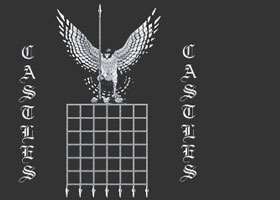A limited number of Carpets and mats were introduced to castle interiors but floors strewed with straw or rushes were generally favored during the Medieval times. Sweet smelling herbs such as lavender, camomile, rose petals, daisies and fennel were added to disguise the bad smells of the castles which were prevalent due to the inadequate plumbing systems! Medieval Great HallDecoration of the Medieval Great Hall
The way a Great Hall was decorated and furnished indicated the wealth of the owner of the castle. At first the interior of the hall was whitewashed. Tapestries and shields and banners displaying coats of arms decorated the walls. Different colored paints were used in considerable quantities - gold paint was a luxurious item which was used in vast quantities! In the later years of the Medieval period a process called wainscoting was introduced in which wooden panels were used to line the walls of a room. Art came to Medieval castle interiors! Medieval Artists were employed and wall paintings covered the walls above the wainscoting. Dining in the Great Hall and the Dais
At the end of the Great Hall was the Dais which was a raised platform for the high table where the highest ranking Lord and Nobles were seated. In medieval England salt was expensive and only afforded by the higher Nobility. These Lords sat on the dais at the 'high table' and their commoner servants at lower trestle tables. The salt was placed in the centre of the high table and only those of the appropriate rank had access to it. Those less favoured on the lower tables were "beneath the salt". The Lord, Lady and Nobles of the castle would eat their food from silverware. Other inhabitants would eat their food from wooden or horn dishes - the following link provides full details of Medieval Food and Drink. Every person had their own knife. Spoons were rarely used as any liquid food was drunk from a cup. Forks were not introduced until the late 14th century. Furniture in the Medieval Great Hall
The Medieval Furniture in the Great Hall was centred around the dining arrangements which were based on the Feudal System in which the status of the inhabitant dictated their lifestyle. Medieval castle furniture was painted! Red and green were the most popular colours used but there are also details in Medieval accounting documents of white, yellow, and black paint. It became fashionable to paint heraldic designs on special pieces of furniture belonging to the Lord of the castle. Individual chairs were quite a luxury and wooden benches were more commonly used furniture to sit on. Trestle tables were used for dining. There were some free-standing tables which were occasionally covered with a linen cloth. Most medieval tables consisted of trestle-tables which enabled quick removal after the meal to make room for entertainment or for the servants to sleep. Buffets - these were a series of wooden planks with a number of stepped shelves. The number of shelves indicated rank! The more shelves the higher the rank. The 'Stepped Buffets' were covered with rich drapes and assembled for use at Banquets and Feasts. The Nobles finest plates of gold or silver were displayed on the 'Buffet' and servants served from them. | 
